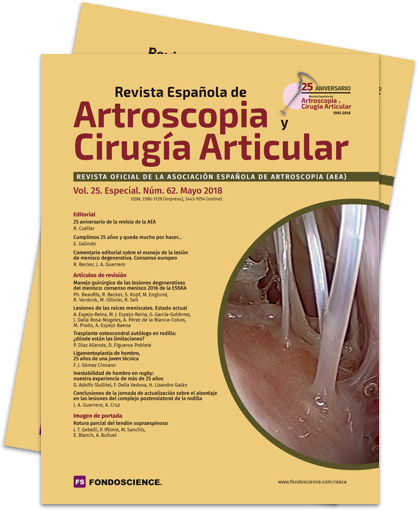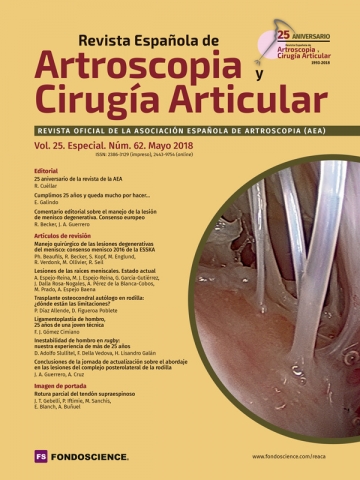El procedimiento más frecuente en cirugía ortopédica y traumatología es la meniscectomía parcial o total por artroscopia. De hecho, es una intervención rápida y sencilla sin aparentes complicaciones y es por ello que no ha sido debatida hasta ahora.
Podemos distinguir dos grupos de pacientes con lesiones meniscales. El primer grupo engloba a pacientes jóvenes que sufren una rotura traumática del menisco, frecuentemente asociada a una lesión del ligamento cruzado anterior. Este tipo de paciente rara vez presenta alteraciones degenerativas en la articulación. En estos casos, la sutura de dicho menisco es la principal recomendación, pues es bien conocido el efecto protector del menisco y, por lo tanto, se evitaría el riesgo de padecer una degeneración precoz de la articulación. La principal función de los meniscos es absorber la carga y repartirla uniformemente(1). Pero, además, son estabilizadores secundarios de la rodilla y juegan un papel importante en la función neuromuscular(2,3).
Sin embargo, ¿qué hacer con un segundo grupo de pacientes, de mediana edad, que presentan una rotura degenerativa del menisco? Este es, actualmente, al grupo que más frecuentemente se prescribe una resección parcial de su menisco en general. Nunca ha existido una recomendación clara, en la literatura científica, de cómo tratar estos pacientes hasta que últimamente se han publicado estudios de nivel 1 donde se compara el tratamiento artroscópico versus conservador de este tipo de lesiones. Estos estudios revelan que no hay diferencias entre el tratamiento quirúrgico y el conservador(4,5,6). Los resultados de estos estudios son diferentes en función del tipo de cirujano ortopédico que lo ha publicado en las últimas décadas. Una selección cuidada de pacientes ha sido incluida en estos estudios de nivel 1. Sin embargo, la práctica clínica ha sido diferente y, por lo tanto, no es de extrañar que estos trabajos hayan suscitado una intensa discusión entre la comunidad mundial de cirujanos ortopédicos. ¿Debemos dejar de practicar cirugía artroscópica en los pacientes con rotura degenerativa de menisco o debemos revisar y modificar nuestra indicación quirúrgica al tratar este tipo de lesiones? Además, en este contexto, también se debe tener en cuenta las repercusiones económicas.
Esta controversia ha estimulado a los miembros de la Sociedad Europea de Cirugía de Rodilla y Artroscopia (ESSKA) a desarrollar un proyecto de consenso, basado tanto en los estudios disponibles en la literatura científica como en la experiencia clínica de expertos en patología de rodilla en Europa(7). Cuando se analizan los estudios de nivel 1, es obvio encontrar limitaciones significantes. La selección de los pacientes y la interpretación de los datos producen también cierta preocupación. A pesar del elevado nivel de los estudios, debemos ser cautos a la hora de utilizar los resultados como guías clínicas de nuestra práctica diaria. Por esta razón se seleccionó un grupo de 84 cirujanos procedentes de 22 países bajo la dirección de Philippe Beaufils de Francia y Roland Becker de Alemania, con el objetivo de encontrar un consenso en el tratamiento de los pacientes que padecen sintomatología por lesiones degenerativas de menisco.
Es verdaderamente el primer consenso donde especialistas de distintos países de Europa tratan de encontrar un acuerdo en el tratamiento de las lesiones degenerativas de menisco, una de las más frecuentes patologías en ortopedia(8).
Partial or total meniscectomy are the most common procedures in orthopedics. The fact that it is a quick and straightforward operation without apparent complications has possibly been one of the reason why the indication of arthroscopic meniscus resection has never been debated in the past.
There are two groups of patients presenting with meniscus pathologies. One group comprises the young patient who sustained a traumatic meniscus tear most commonly in conjunction with anterior cruciate ligament injury. These patients rarely present significant signs of osteoarthritis. Meniscus repair should be considered as the primary treatment option because the protective function of the meniscus is well known to avoid an increase in risk of early osteoarthritis. The menisci serve for the knee as shock absorber, load distributer(1). They are also secondary stabilizer for the knee and have important neuromuscular function(2,3).
However, what about the second group, which is the middle-aged patients who presents a degenerative meniscal lesion? It is the largest group of patients treated with arthroscopic partial meniscectomy in general. There has never been a clear recommendation in the literature about the management of these patients until the level one studies were published more recently comparing arthroscopic surgery with conservative treatment of degenerative meniscus lesions. These studies reported about no clinical difference in the outcome between arthroscopic surgery and conservative treatment(4,5,6). The results of the level 1 studies were different from what orthopaedic surgeons have experienced over the last decades. Highly selected patients were included in these level 1 studies. However clinical practise is different and thus is was not surprising that these studies caused an intensive discussion between orthopeadic surgeons throughout the world. Do we have to stop arthroscopic surgery in patients suffering on degenerative meniscus lesions or do we have to revise and modify our indications for arthroscopic surgery when treating these patients? Health economic aspects have been discussed in the context as well.
This controversy stimulated members of the European Society of Knee Surgery and Arthroscopy (ESSKA) to initiate a consensus project based on both the latest knowledge from highest scientific clinical studies available in the literature and the clinical experience of knee experts throughout Europe(7). When analysing the level 1 studies significant limitations in most of them became obvious. Patients selection and the interpretation of the data were of some concern. Despite the highest scientific level of these studies one should be cautious to use the results as guidelines for our daily practise. There was a group of 84 surgeons and researcher from 22 countries involved in the project under the lead of Philippe Beaufils from France and Roland Becker from Germany, with the aim of finding a consensus in the treatment of patients suffering on symptomatic degenerative meniscus lesions.
It is the first true consensus where people from many countries of Europe were involved to find an agreement in the treatment of degenerative meniscus lesions one of the most common pathology in orthopeadics(8).




